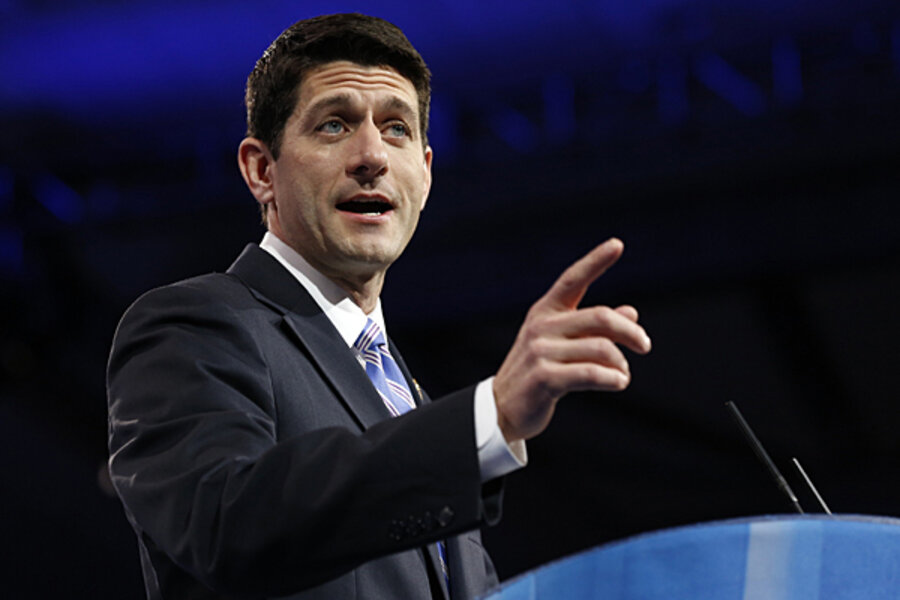The $5.7 trillion question in Paul Ryan's budget
Loading...
House Budget Committee Chair Paul Ryan’s (R-WI) fiscal plan promises to balance the federal budget in 10 years, make major cuts in income tax rates for both individuals and corporations, and raise the same amount of revenue as current law. If House Republicans want to do all three, they will have to eliminate trillions of dollars in popular tax preferences.
The Tax Policy Center estimates that cutting individual rates to 10 percent and 25 percent, repealing the Alternative Minimum Tax and the tax increases included in the Affordable Care Act, and cutting the corporate rate from 35 percent to 25 percent would add $5.7 trillion to the deficit over the next decade. Thus, if House Republicans want to cut these taxes and still collect the revenues they promise, they’d have to raise other taxes by $5.7 trillion.
The tax cuts described in Ryan’s budget would generate a huge windfall for high-income taxpayers. On average, households would get a cut of $3,000. But those in the top 0.1 percent of income, who make $3.3 million or more, would get a whopping $1.2 million on average–a 20 percent increase in their after-tax income.
By contrast, middle-income households would get an average tax cut of about $900. Those in the bottom 20 percent (who make $22,000 or less) would get $40 and one-third of them would get no tax cut at all.
Some important caveats here: TPC did not estimate the revenue effects of a Ryan tax proposal since the budget does not include an actual plan. Rather, it modeled generic tax cuts that follow the outline of what his budget describes. And because his plan does not identify any tax increases, TPC modeled only the tax cuts.
The Ryan budget anticipates sufficient cuts in tax preferences so that a rewritten tax code raises the same amount of money as current law. But it leaves the details to the House Ways & Means Committee, which could make major changes in the budget panel’s plan.
TPC included in its revenue estimates two Obamacare tax increases on high-income households—the additional 0.9 percent Medicare tax and the new 3.9 percent tax on investment income. However, we excluded other provisions from the 2010 health law, including revenue the House budget would generate by eliminating insurance subsides or roughly the same amount Treasury would lose if other provisions of the 2010 health law are repealed.
Could Ways & Means find $5.7 trillion in tax preferences? It is hard to imagine.
For instance, OMB projects about $1.8 trillion in tax expenditures in 2017 under current law. TPC figures Congress would have to cut about $539 billion in that year to cover the revenue lost through Ryan-like rate cuts. That would slash deductions, credits, tax exclusions, and preferential rates by nearly 30 percent.
But that underestimates the size of the necessary tax hikes. There are three reasons why:
The first that the simple act of lowering rates makes tax expenditures less valuable. With a top rate of 39.6 percent, a $1 deduction is worth 39.6 cents to a top bracket taxpayer and Treasury loses the same 39.6 cents. If Congress cuts the top rate to 25 percent, the deduction would be worth less and eliminating it would produce fewer dollars for the Treasury.
The second problem is that people will change behavior as they lose tax benefits, and that will reduce the amount of money government will collect. Take away my mortgage interest deduction and, if I can afford it, I’ll just pay off my mortgage.
The third problem is that many tax expenditures are untouchable. For instance, does anybody really want to tax combat pay? Or imputed rent on the value of owner-occupied homes? Will Republicans raise rates on capital gains? If not, other preferences would have to take a bigger hit.
Finally, because the rate cuts are so regressive, House Republicans would have to heavily skew offsetting tax increases to high-income households if they want to keep the distribution of taxes roughly what it is today. And that will be another heavy lift.
In the end, the Ryan budget is only half-a-plan. It outlines politically attractive tax cuts but says nothing about the tax increases necessary to pay for them. It leaves us with little more than a black box. The TPC numbers show just how big that box is.







